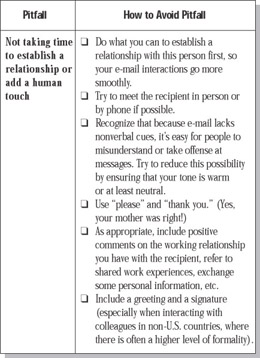Chapter 15: How to Make an Effective Presentation About Your Six Sigma Project
Every interaction with others in your organization is an opportunity to either increase or decrease support for your project. If you’re like the majority of Six Sigma team members, e-mail is one of the primary ways—if not the primary way—you interact with those whose support you need. So you’ll want to be sure you know the pitfalls of communicating with e-mail ... and how to make sure you don’t fall into them and inadvertently create resistance instead of support.
What to Do:
Use the checklist in Tool 14-1 to help you avoid the typical pitfalls of e-mail on Six Sigma projects. While it may seem cumbersome to run through this list for every e-mail you send, the goal is to make this way of thinking automatic. Try it a few times and soon you won’t even have to look at the list ... and you’ll increase the level of support and cooperation for your project.
Checklist: E-Mail Pitfalls and Avoiding Them
Tool 14-1.


Reality Check
Here’s an example of an e-mail we saw that wasn’t very effective:
I’m still waiting for your month-end figures. My deadline is Friday.
Jim, the recipient of this e-mail, did not report to Beth, the sender, nor did he know her well. So he certainly wasn’t expecting to get what appeared to be a command from her. And didn’t she recognize that he had his own work to do and his own deadlines? Needless to say, Jim did not immediately leap into action upon receipt of this message. Nor was his impression of Beth enhanced.
Beth, meanwhile, couldn’t figure out why she didn’t get a quick answer from Jim. She knew he got the e-mail, since she’d gotten the receipt. It struck her that perhaps Jim just wasn’t a team player. It never occurred to Beth that perhaps her curt and seemingly demanding e-mail might have played a part in Jim’s response (that is, his lack of response).
Most people think they get too much e-mail, and some argue that readers appreciate concise e-mails. That may be true, but we still think the following would have been more likely to get results for Beth:
Hi Jim,
Thanks for getting back to me so quickly with the numbers for last quarter. I’d like to include last month’s figures, too, when I give my report this Friday. Could you possibly send me a copy of your month-end report by Thursday? I know you’re probably in the middle of a lot of other things, so please let me know if there’s anything I can do to help you on this.
Thanks!
Beth
Better still, Beth might have stopped by Jim’s office and asked for a copy in person. Had Beth considered the Checklist: E-Mail Pitfalls and Avoiding Them before sending her message, she likely could have gotten what she needed when she needed it.
EAN: 2147483647
Pages: 65
- ERP System Acquisition: A Process Model and Results From an Austrian Survey
- The Effects of an Enterprise Resource Planning System (ERP) Implementation on Job Characteristics – A Study using the Hackman and Oldham Job Characteristics Model
- Context Management of ERP Processes in Virtual Communities
- Distributed Data Warehouse for Geo-spatial Services
- A Hybrid Clustering Technique to Improve Patient Data Quality
- Chapter IV How Consumers Think About Interactive Aspects of Web Advertising
- Chapter VI Web Site Quality and Usability in E-Commerce
- Chapter VII Objective and Perceived Complexity and Their Impacts on Internet Communication
- Chapter VIII Personalization Systems and Their Deployment as Web Site Interface Design Decisions
- Chapter XII Web Design and E-Commerce